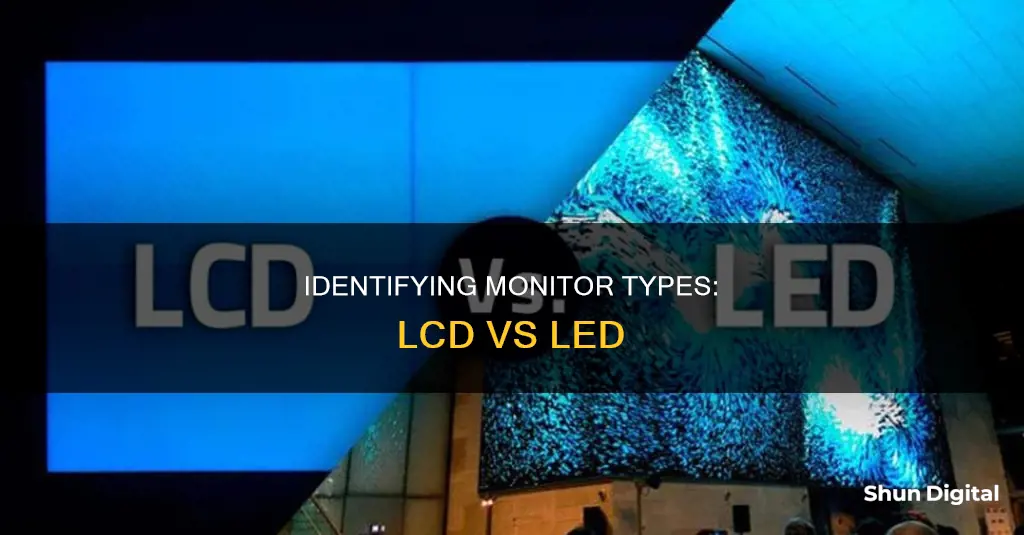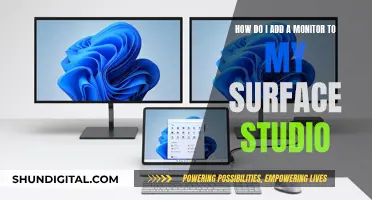
If you're unsure whether your monitor is an LCD or an LED, you're not alone. All LED monitors are LCD monitors, but not all LCD monitors are LEDs. LED monitors are a subtype of LCD that uses an LED backlight instead of fluorescent. LCD monitors use liquid crystals to help create an image, and the difference lies in the backlights. While a standard LCD monitor uses fluorescent backlights, an LED monitor uses light-emitting diodes.
| Characteristics | Values |
|---|---|
| LCD displays | Most common displays in daily life |
| Used in various devices from mobile phone screens to home appliances | |
| Require a separate light source positioned behind the LCD matrix | |
| Older LCD screens use CCFL (Cold Cathode Fluorescent Light) to light up the screen | |
| Newer LCD screens use LED backlighting | |
| LED displays | Self-illumination characteristics |
| High outdoor visibility and brightness | |
| No viewing angle problems | |
| More energy efficient | |
| Serve longer than CCFL | |
| More expensive | |
| Superior picture quality |
What You'll Learn

All LED monitors are LCD monitors, but not all LCD monitors are LEDs
LCD stands for liquid crystal display. Liquid crystals are used in both LCD and LED monitors to help create an image. However, the key difference lies in the backlights. A standard LCD monitor uses fluorescent backlights, typically in the form of cold cathode fluorescent lamps (CCFLs). On the other hand, an LED monitor uses light-emitting diodes (LEDs) for backlights, which offer superior picture quality.
To put it simply, an LED monitor is a subtype of LCD monitor that uses LED backlighting instead of fluorescent. So, when you see a screen described as an "LED screen", it usually means it's an LCD panel with an LED backlight. This combination of LCD and LED technologies offers several advantages. LED backlights provide higher energy efficiency and longer lifespans than traditional CCFL backlights. They also enable local dimming, which improves picture quality by allowing for a higher contrast ratio.
However, it's worth noting that not all LED monitors are created equal. LED monitors come in varying backlight configurations, such as full-array backlighting and edge lighting, which can impact the viewing experience. Full-array backlighting provides superior picture quality and better viewing angles, making it ideal for gaming. In contrast, edge lighting is more affordable and allows for thinner displays but may result in issues with glare and visibility from non-centre viewing angles.
When shopping for a monitor, it's important to consider not only the backlighting type but also other specifications like resolution and refresh rate. The resolution refers to the number of pixels displayed on the monitor, impacting the colour dynamics of the image. The refresh rate, on the other hand, is the speed at which the monitor updates with new information, affecting the smoothness of the display.
Asus ROG Monitors: Worth the Hype and Price?
You may want to see also

LED monitors use light-emitting diodes for backlights
LED monitors use light-emitting diodes (LEDs) for backlights, while standard LCD monitors use fluorescent backlights. Both types of displays use liquid crystals to help create an image, but the backlights are what set them apart.
LCD stands for liquid crystal display. Liquid crystals act like little shutters, becoming transparent when electricity is applied to them. Each pixel is composed of three colour filters, or "subpixels": red, blue, and green. The liquid crystals are sandwiched between two glass sheets, with the outermost sheet containing the subpixels.
LCD monitors have backlights that emit white light, but this light cannot pass through the liquid crystals when they are in their liquid arrangement. When the pixel is in use, an electric current is applied to the liquid crystals, causing them to straighten out and allow light to pass through.
In contrast, LED monitors use light-emitting diodes as their backlights, which are extremely small lights. There are two methods of LED backlighting: full-array backlighting and edge lighting. With full-array backlighting, the LEDs are placed evenly across the screen in zones, allowing for local dimming to improve picture quality. Edge lighting places the LEDs along one or more edges of the screen, resulting in thinner displays that are more affordable but may have inferior picture quality and viewing angles compared to full-array LEDs.
While the names LCD and LED can be confusing, understanding the underlying technology helps clarify the differences. LED monitors are a subtype of LCD monitors that use LED backlights instead of fluorescent ones. So, when you see "LED screen", it typically refers to an LCD panel with an LED backlight.
Asus Predator Monitors: Unlocking the Power with Nvidia
You may want to see also

LCD monitors use fluorescent backlights
LCD stands for liquid crystal display. All LCD monitors use liquid crystals to help create an image, but they differ in the backlights they use. While a standard LCD monitor uses fluorescent backlights, an LED monitor uses light-emitting diodes for backlights.
LCD monitors use "cold cathode fluorescent lamps" (CCFLs) as backlights. These fluorescent lights are placed evenly behind the screen to deliver consistent lighting across the display. This means that all regions of the picture will have a similar brightness level.
In contrast, LED monitors use "light-emitting diodes" as backlights. These are extremely small lights that can be arranged in two ways: full-array backlighting and edge lighting. With full-array backlighting, the LEDs are placed evenly across the entire screen, similar to an LCD setup, but they are arranged in zones that can be dimmed independently. This local dimming feature can dramatically improve picture quality by creating images with a high contrast ratio.
LED monitors with edge lighting place the LEDs along one or more edges of the screen rather than behind it. This enables manufacturers to create extremely thin displays that are more affordable, but they may have issues with glare and offer fewer optimal viewing angles.
While both LCD and LED monitors use liquid crystals, it is the backlighting that makes them different from each other. LCD monitors with fluorescent backlights provide consistent lighting across the display, while LED monitors with light-emitting diodes offer improved picture quality, thinner designs, and lower prices, depending on the type of backlighting configuration.
Signs Your Data is Being Monitored: What to Look For
You may want to see also

LED monitors have superior picture quality
- Improved Visual Clarity and Colour Accuracy: LED monitors provide better colour accuracy and improved visual clarity due to their LED backlighting technology. The colours produced by LEDs are more accurate and consistent, resulting in a clearer and more vibrant image.
- Higher Contrast Ratios: LED monitors, especially those with full-array backlighting, offer higher contrast ratios compared to LCD displays. This means deeper blacks and better contrast, enhancing the overall picture quality, especially in dark scenes.
- Faster Response Times: LED monitors typically have faster response times, reducing motion blur and ghosting. This is particularly beneficial for gaming and fast-paced content, ensuring a smoother viewing experience.
- Longer Lifespan: LED monitors tend to have a longer lifespan than LCD monitors due to the durability of their backlighting technology. LED backlights can last up to 100,000 hours, compared to 30,000 to 60,000 hours for traditional CCFL backlights in LCDs.
- Wider Viewing Angles: LED monitors, particularly those using IPS (In-Plane Switching) technology, offer wider viewing angles. This means that colours and contrast remain consistent and accurate even when viewing the screen from different angles, providing a superior viewing experience for multiple viewers.
- Energy Efficiency: LED monitors are more energy-efficient than LCDs, requiring less power to produce the same level of brightness. This not only reduces power consumption but also leads to lower electricity bills over time.
While LCD monitors have their advantages, such as lower cost and reduced glare with matte screens, LED monitors excel in delivering superior picture quality. The advancements in LED technology result in a more visually appealing and accurate display, making LED monitors a preferred choice for activities like gaming, graphic design, and video editing.
Understanding RGBW Tilting LCD Monitors: Ultimate Viewing Experience
You may want to see also

LED monitors are more energy efficient and last longer than CCFL
LED monitors are a subtype of LCD monitors that use light-emitting diodes (LEDs) for backlighting. This newer technology offers several advantages over the traditional cold cathode fluorescent lamp (CCFL) backlighting used in older LCD monitors.
One of the key benefits of LED monitors is their energy efficiency. LED backlighting consumes less power than CCFL backlighting, resulting in lower electricity costs and extended battery life for portable devices. This lower power consumption also leads to reduced heat generation, improving the energy efficiency of the monitor overall.
In addition to being more energy-efficient, LED monitors offer improved image quality. LEDs are capable of higher brightness and can produce brighter and more vibrant colours and contrast, enhancing the viewing experience and image quality. This higher brightness also makes LED monitors more suitable for use in environments with direct sunlight, as the onscreen display will not be adversely affected.
Another advantage of LED monitors is their thinner and lighter design compared to CCFL-backlit LCD monitors. This makes LED monitors more suitable for slim and portable devices. Furthermore, LED monitors have a longer lifespan than CCFL-backlit LCD monitors, especially when properly maintained and not overused.
While LED monitors offer superior performance and energy efficiency, their higher price can be a drawback for some. However, with more manufacturers adopting LED technology, prices are becoming more competitive. In the long run, LED monitors can be more cost-effective due to their lower power consumption and longer lifespan.
Troubleshooting ASUS Zen AIO Monitor Sleep Issues
You may want to see also
Frequently asked questions
All LED monitors are LCD monitors, but not all LCD monitors are LEDs. LED monitors are a subtype of LCD monitors that use an LED backlight instead of fluorescent.
The easiest option is to look for stickers or model information indicating the backlight type. You can also check if the monitor has a backlight in the area where nothing is displayed.
Yes, standard LCD monitors typically use "cold cathode fluorescent lamps" or CCFLs as backlights.







